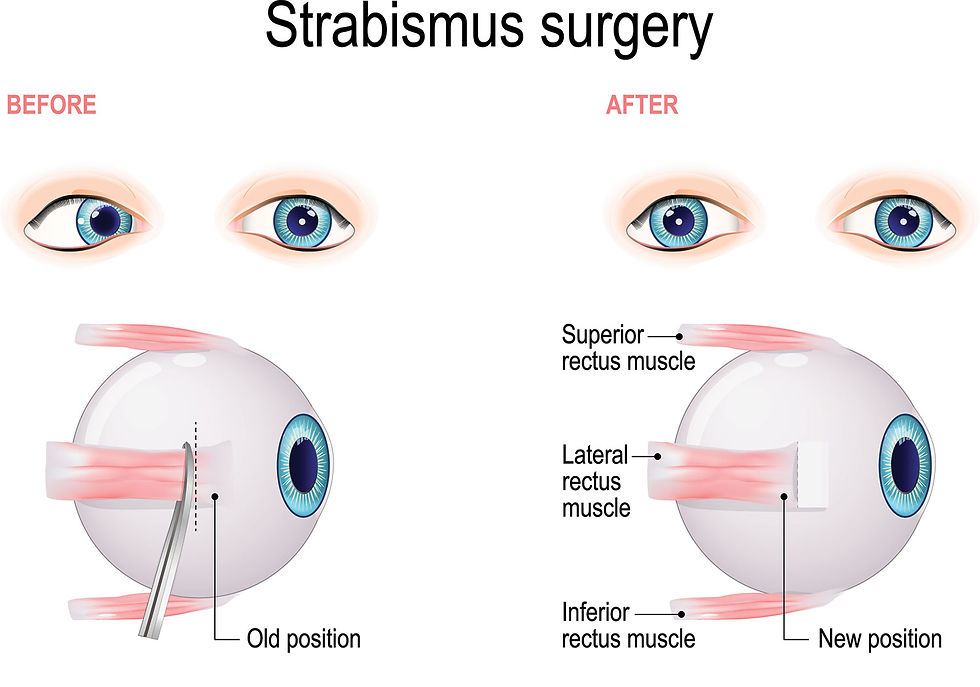June 2025 Newsletter: Strabismus
- Carisa Gorpas
- Jun 28, 2025
- 2 min read
Updated: Jun 30, 2025
What is Strabismus?
Strabismus is a condition where the eyes do not align properly. One eye may turn in, out, up, or down while the other remains focused. This misalignment can be constant or intermittent and may affect one or both eyes. Strabismus disrupts binocular vision, the ability of the eyes to work together, leading to difficulties with depth perception. If untreated, especially in children, it can result in amblyopia (commonly known as “lazy eye”) and long-term vision problems.
Causes of Strabismus
Congenital factors
Genetic predisposition
Refractive errors (uncorrected farsightedness)
Eye muscle disorders
Stroke or head Trauma
Nerve injuries
Abnormalities controlling eye muscles
Cerebral Palsy
Down Syndrome
Tumors or lesions
Types of Strabismus
Not all strabismus looks the same. There are actually different types, depending on which way the eye turns. The most common ones include:
Esotropia – when one or both eyes turn inward (this is what people usually think of when they hear "crossed eyes")
Exotropia – when one or both eyes drift outward, especially when someone is tired or staring off into the distance
Hypertropia – when one eye turns upward
Hypotropia – when one eye turns downward
Some people have strabismus all the time (constant), while others only have it sometimes (intermittent). It can also switch from one eye to the other, depending on the person. Understanding the type helps doctors figure out the best treatment plan.

Symptoms
Eyes that appear to wander or do not move together
Tilting or turning the head to see better
Difficulty with depth perception
Double vision (more common in adults)
Squinting or closing one eye, especially in bright light
Eye fatigue or strain
How is Strabismus Diagnosed?
Diagnosing strabismus requires a thorough eye examination by a medical professional:
Visual acuity testing (check clarity of vision)
Cover test (to detect hidden misalignment)
Retinal examination (to rule out underlying problems)
Neurological evaluation (if a nerve-related cause is suspected)
Corneal light reflex test (to assess alignment)
Treatment Options
Treatments for strabismus depends on the cause, age of the patient, and severity:
Non-Surgical Approaches:
Eyeglasses or contact lenses (especially for refractive strabismus)
Eye patching the stronger eye to treat amblyopia
Prism lenses to help align images
Vision therapy (eye exercises to strengthen eye coordination)
Surgical Options:
Eye muscle surgery (adjusts the positioning or strength of eye muscles)
Surgery is often followed by visual therapy to attain optimal results
Neurological causes:
Treat underlying conditions
Use of temporary prism or botox injections to reduce muscle imbalance

Prevention and Management
While not all cases are preventable, early detection is key, especially regarding children. To prevent vision problems and promote healthy and standard eye alignment:
Have your children attend eye exams by age one and before school
Follow up regularly with a specialist if your child may have a genetic predisposition
Manage other health conditions that may be related to the eyes
With Strabismus being relatively common, there are many treatment options, however this can be misleading and make us take the condition for granted. Don’t push off appointments and take care of you and your children before the effects of Strabismus become permanent.
_edited.png)


